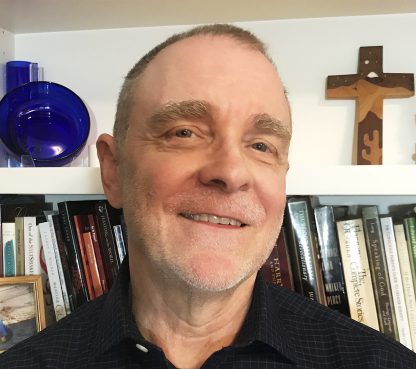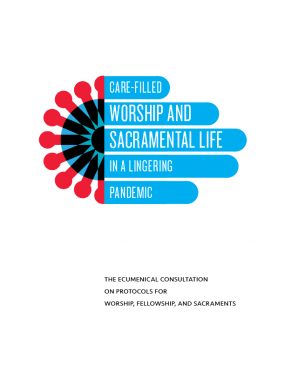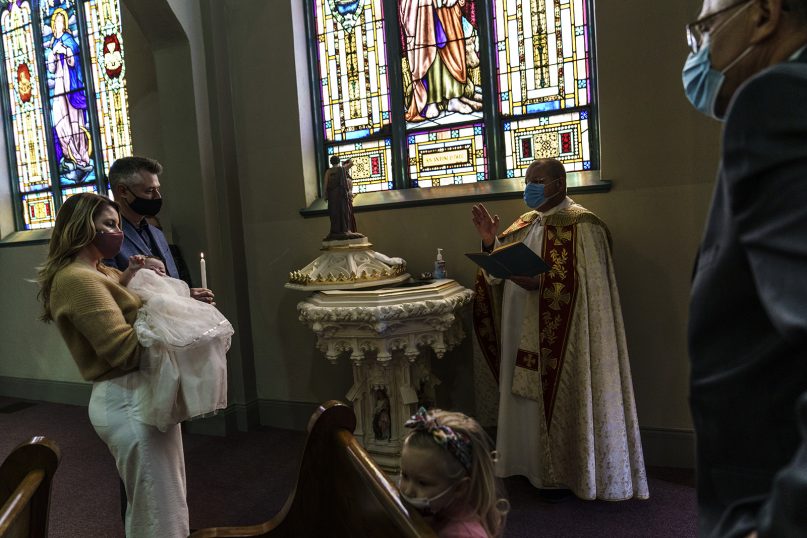(RNS) — Some Americans may be behaving like the COVID-19 pandemic no longer hinders them from socializing with friends and family, many of whom they may not have seen in months.
But the Ecumenical Consultation on Protocols for Worship, Fellowship, and Sacraments, a group of clergy, scientists and other experts, advised congregations to take it slower at houses of worship, where vaccinated and unvaccinated people may occupy the same space.
Its final document, released Tuesday (June 8), recognizes that “staying the course” can be difficult if congregants complain about continuing masking and distancing, but the limits, “with the Spirit’s empowerment, can become a spring of creativity.”
The group suggests limiting touching except where Christian rituals, such as laying on of hands for confirmation, require it; avoiding congregational singing and playing wind instruments indoors; wearing masks when preaching indoors — or outdoors closer than 16 feet from listeners. Singing, which has been shown to spread the virus especially effectively, should be limited to soloists or ensembles kept well distanced.
Indoor worship, the group cautioned, should be briefer than outdoor gatherings.
“Care-filled Worship and Sacramental Life in a Lingering Pandemic” is the final guidance from United Methodist, Evangelical Lutheran, Episcopal and Roman Catholic leaders, as well as representatives from other traditions. Its first such guidance was released in June 2020.
A Spanish version of the latest guidance is scheduled to be released in mid-July.
RELATED: Is it safe to sing at church yet? Depends who you ask.
Experts on congregational responses to the pandemic often declare that they cannot give one-size-fits-all recommendations. And the consultation has taken the same approach.

The Rev. Ed Phillips. Courtesy photo
“Different congregations will determine different approaches to what they consider safe and what levels of risk they’re willing to take,” said the Rev. Ed Phillips, co-convener of the Ecumenical Consultation on Protocols for Worship, Fellowship, and Sacraments.
The 35-page guide takes a “relatively conservative approach,” Phillips said, because its writers think it is safest to keep wearing masks until federal officials declare it is safe to remove them, regardless of vaccination status.
“We will for some time have people who are not vaccinated yet,” said Phillips, associate professor of historical theology and Christian worship at Emory University’s Candler School of Theology. “And what we don’t want to do is to engage in any kind of stigmatization, or public shaming of people who are not vaccinated for whatever reason it may be.”
So while outdoor gatherings can be an hour or longer, indoor worship services should be 30 to 45 minutes, “depending on the rate of air exchange,” the guide recommends, noting that, while its recommendation for “maximum time indoors assumes at least 4 to 6 air exchanges per hour,” many buildings don’t come close.

“Care-filled Worship and Sacramental Life in a Lingering Pandemic” cover. Courtesy image
Brian Hehn, a member of the consultation has separately suggested checking with heating and air conditioning providers for advice.
Administering sacraments presents particular challenges. The guide outlines procedures for handling the elements during the prayers before Communion — which should be said with a mask on when indoors. For baptism, one of its more than one-dozen suggestions includes having a parent or caregiver hold the infant during the rite.
The guide also features advice for weddings and funerals and for Communion servers “extending the Table of the Lord” by visiting people at home, topics discussed in earlier versions of the consultation’s guidance.
The guide also urges addressing the mental health of clergy by offering renewal opportunities for congregational leaders who may be physically and mentally fatigued after adapting new practices during the pandemic.
Advice about congregational care in the midst of COVID-19 has been heavily sought, as the Centers for Disease Control and Prevention has not updated its “Considerations for Communities of Faith” page since Feb. 19.
“While the CDC guidance issued in late April 2021 considers choral singing indoors safe for vaccinated people wearing masks, it still ranks choral singing indoors for those who are unvaccinated as ‘least safe,’” the guide notes.
RELATED: When churches reopen, don’t sing or shake hands, do make sermons short, says new guide
More than 750 people showed up for a June 1 “Return to Congregational Singing” webinar hosted by Practical Resources for Churches, a nondenominational nonprofit that offers workshops and resources to congregations.

Brian Hehn speaks during a webinar on congregational singing on June 1, 2021. Video screengrab
Hehn, director of the Hymn Society’s Center for Congregational Song, noted in the webinar that the CDC’s mid-May guidance saying fully vaccinated people could resume activities without wearing a mask was about individuals, not organizations.
“As the church, we have to ask extra questions, not only, for instance, is it safe for most people,” he said. “That’s a question that might work in other circumstances, but as the church, that’s leaving out a critical theological question of who’s it not safe for? And is that OK for us not to advocate for those people?”
In a May 20 blog post published shortly after the new CDC guidelines, Hehn’s center declared: “We do not currently recommend that congregations sing.”
Participants filled the webinar’s chat function with comments and questions about how to handle everything from air quality to musicians who decline to get vaccinated.
“Our adamantly unvaccinated and unmasked song leader/accompanist is still Zooming from home although more and more of us are attending in person,” wrote one participant. “Most congregants don’t want her back in the building right now.”
The guide’s writers seemed familiar with such scenarios. “You will want to have a plan for gently reminding persons of such requirements to participate in in-person activities, and for inviting them to return when they are willing to follow them,” it said.
The guide also anticipates a question many congregants are asking: “When do these limits end?”
“Congregations can help bring an end to restrictions by encouraging all their members who meet the requirements to be vaccinated as soon as possible,” it said.
RELATED: Clergy, scientists grapple with thoughts of worship without congregational singing





